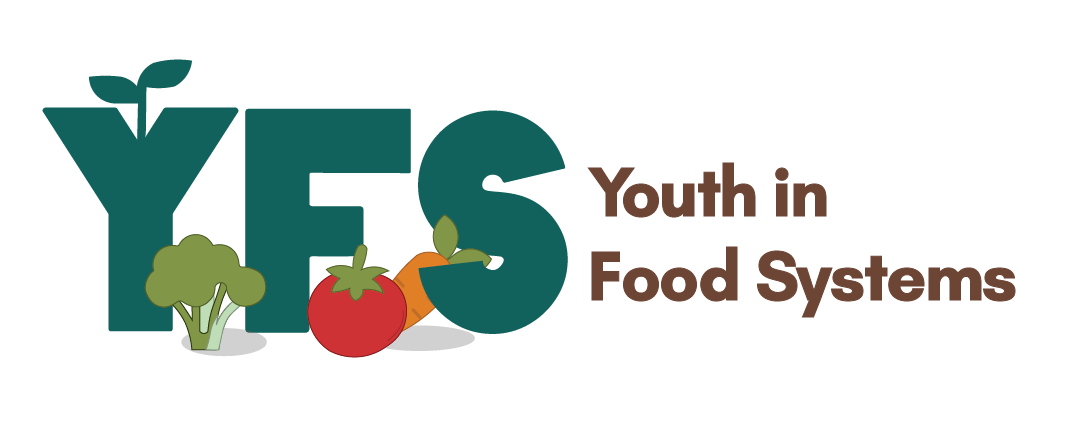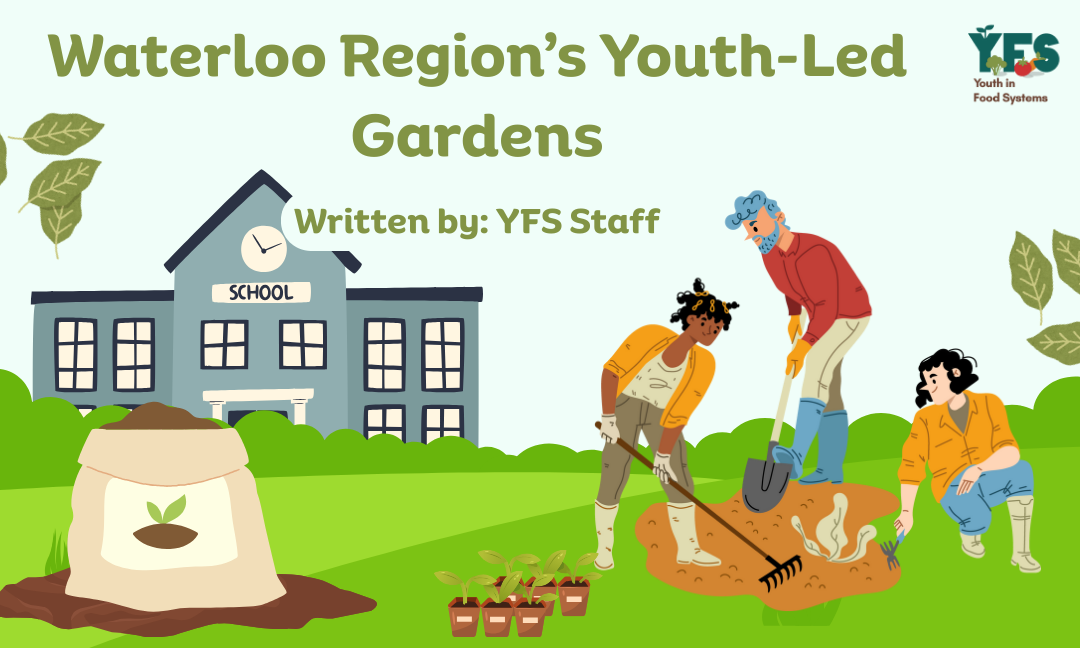This week marks the end of our summer activities, as the start of the new school year grows closer and closer. And with this end, we say goodbye to our youth Garden Leaders!
Since 2017, Youth in Food Systems has been supporting school-based food production, building our network of 47 gardens across the Region. And since 2021, we have been operating youth teams in gardens over the crucial summer months when schools are out and many spaces don’t have reliable maintenance plans. This enables the gardens to keep flourishing while simultaneously having valuable, hands-on space for youth learning and leadership. It’s truly a win-win!
During 2023 and 2024, our beloved partner, Nurture, spearheaded the youth-led gardens in collaboration with our programming. Sadly, due to funding cuts they were unable to continue operating so YFS was back at it for 2025!
This year, we selected six garden spaces based on the need for summer support, garden size and capability to grow a meaningful amount of food, and the proximity to our Market locations (more on this in tomorrow’s blog post!)
So, what did the season look like? How did it go?
In June, we hosted the Garden Leader training day at Kitchener Waterloo Collegiate Institute in Kitchener, where 20 youth came out to learn about growing, caring for, and harvesting food, supporting community, and working collaboratively to carry out real in-garden projects. This was their first chance to meet one another and the adult allies working alongside them.
Then, for eight weeks, they took over! Each garden consisted of 3-8 youth working to care for and improve the spaces, and harvesting regularly for the Youth Food Market. Each team had a $200 Garden Improvement Fund to support their own creations and ideas in the garden. The prompt: how can you, as a team, leave the space better than the way you found it in early July?
Each team also had a Garden Mentor to call upon for support and expertise throughout the summer. Massive thank-you to Maddy, Nancy, Barbara, Shane, Paul, and Jessica for the passion and care they brought to the project.
A look at the numbers: In total, 24 youth spent approximately 400 hours in the gardens, harvesting at least 150 pounds of produce, and spent an additional 265 hours in community based activities to grow and nurture their learning and leadership.
Read about and see each of the spaces below!
CAMERON HEIGHTS C.I.
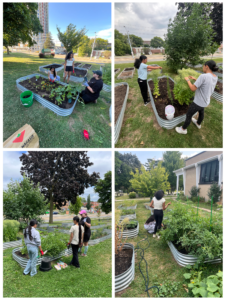 The garden space at Cameron Heights is unique, as it’s entirely created and run by a team of youth during the school year. As Niranjana, Ashley, and Jahanvi, our Cameron Heights garden team, considered what would be the most impactful garden improvement projects, they wanted to ensure that they kept their projects adaptable and simple, making them easy to pass on as youth leads at the garden are expected to change year over year.
The garden space at Cameron Heights is unique, as it’s entirely created and run by a team of youth during the school year. As Niranjana, Ashley, and Jahanvi, our Cameron Heights garden team, considered what would be the most impactful garden improvement projects, they wanted to ensure that they kept their projects adaptable and simple, making them easy to pass on as youth leads at the garden are expected to change year over year.
The team, with the help of their garden mentor Maddy, settled on two ideas; a trellising system for tomatoes and a waterproof labeling system for what’s growing in the garden beds. During their first few weeks in the garden the team experienced the challenge of keeping up with tomatoes that weren’t trellised, and trying to remember what was planted in each and every bed in the garden. They were determined that there could be a better solution! The team research potential solutions to both of these challenges and settled on a trellising system that could be set-up each year in whichever bed tomatoes are placed and designed a labeling system where labels are attached by magnets and replaceable making them be able to be updated as the garden changes throughout the seasons and over the years!
EASTWOOD C.I.
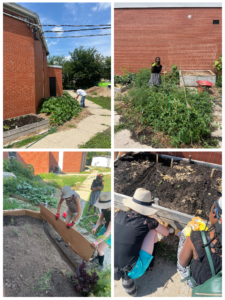 The youth team at Eastwood, Klara, Godlymodel, Agatha, and Guradit, had a fun challenge as they considered what garden improvement projects could be installed in the spaces they were stewarding over the summer. A lot of ideas were considered and even a few of them were addressed without eating into the improvement fund, such as the swale they created, with the help of their garden mentor Barbara, out of cardboard and wood chips that were on site.
The youth team at Eastwood, Klara, Godlymodel, Agatha, and Guradit, had a fun challenge as they considered what garden improvement projects could be installed in the spaces they were stewarding over the summer. A lot of ideas were considered and even a few of them were addressed without eating into the improvement fund, such as the swale they created, with the help of their garden mentor Barbara, out of cardboard and wood chips that were on site.
The team ended up settling on two main projects, creating tent-like tomato trellising and helping Eastwood to start realizing their goal of creating a food forest. Similar to other schools, the team found it challenging to keep up with the tomatoes as they grew more and more densely; the team’s tent-like trellising has helped to open up the patch of tomatoes! Over the course of a few conversations, the youth learned about the school’s goal of creating a food forest where perennial plants could be established to create spaces at the school where food could be gathered without the consistent maintenance required of a traditional garden. They learned about the apple, cherry, and pear trees that were planted last year and that the next step was to plant a guild of perennials amongst the trees. Determined to focus on this project, and considering the limited funding, the team determined 3 trees they’d plant perennials around as a test for the school. The team hopes the school will observe how this initial planting does, improve upon its design and expand it as the years progress.
GALT C.I.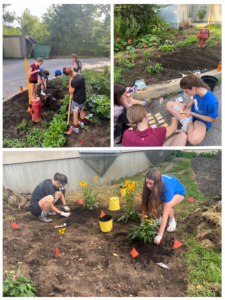
In our first year working with the Galt school garden, the garden leaders were dedicated to making this space their own. Despite a few setbacks, once being mowed over and another time driven across, the garden still flourished with delicata squash, jalapeno peppers, mustard spinach, turnips, and cherry tomatoes. As the garden grew, the youth understood the importance of attracting pollinators. They spent time researching and became set on designing a beautiful pollinator garden.
After collaborating on different ideas, they finalized their plan to create a spiral pollinator garden. They set off to work diligently for two weeks, digging out the plot and finding interesting rocks and trinkets buried along the way. They planted a mix of perennials, wildflower seeds, milkweed, and goldenrod, adding creative touches like a bird bath, bee baths and a secret garden gnome friend! While the garden is just starting, soon it will be bustling with bees, butterflies, and other pollinator critters for all to enjoy!
MARGARET AVE S.P.S.
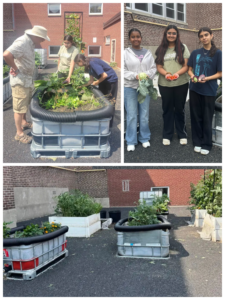 This summer at Margaret Avenue was all about resilience. Snit, Maheen, Dania, and Bhavika kicked things off by planting new swiss chard, spinach, carrots, and lettuce, while also staking all of the tomatoes. The season came with challenges since the garden was unfortunately vandalized on four separate occasions. Each time, the team showed determination by stepping up to replant, clean up, and even harvest things to take home.
This summer at Margaret Avenue was all about resilience. Snit, Maheen, Dania, and Bhavika kicked things off by planting new swiss chard, spinach, carrots, and lettuce, while also staking all of the tomatoes. The season came with challenges since the garden was unfortunately vandalized on four separate occasions. Each time, the team showed determination by stepping up to replant, clean up, and even harvest things to take home.
Alongside maintaining the back garden, they worked on a big new project, which involved creating a new teaching garden filled with Southern Ontario native perennials. With guidance from Terre, a local community member who shared Indigenous knowledge, the team developed a woodland garden plan designed for the space. After marking out the area with pegs and string, they measured, tilled the soil, added compost, and with the help from the Resurrection team and community volunteers, began planting.
Now the space is home to spicebush, trillium, bee balm, woodland strawberry, Solomon’s seal, and more. All the plants were sourced from Bill at Origin Native Plants in Guelph, who generously donated a few extras to help us fill in the space. With everything mulched and ready for the cooler months, the garden stands as a true symbol of perseverance and community care.
RESURRECTION C.S.S.
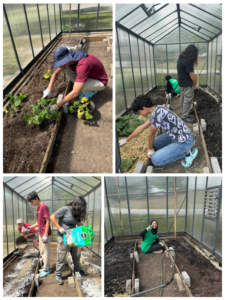 During the very first week in the Resurrection garden, Melissa, Taleen, and Adam were so excited about all the possibilities for transforming the space. Resurrection is extra special because it doesn’t have just one garden, it actually has four!
During the very first week in the Resurrection garden, Melissa, Taleen, and Adam were so excited about all the possibilities for transforming the space. Resurrection is extra special because it doesn’t have just one garden, it actually has four!
This summer, we put in lots of work across all four spaces, including the beds in the front, a big bed in the back, a food forest, and even a greenhouse. We weeded, pruned, halved giant perennials, moved the rain barrel to the food forest to make watering easier, and gave the shed a full clean-out. But the real highlight was the greenhouse project. We kicked things off by repurposing old planks and bricks to build a new frame, then mixed up some fresh soil with compost, vermiculite, perlite, and mulch. We moved our spaghetti squash inside, where it thrived, and planted peas, radishes, beets, carrots, and more. To keep everything healthy in the heat, Adam suggested the genius idea of setting up an irrigation hose around the greenhouse and adding two soil moisture monitors. With a final layer of straw mulch, the space was transformed. The team put SO much effort in, and now with Green Industries continuing into the school year, their impact will keep growing!
ST. BENEDICT C.S.S.
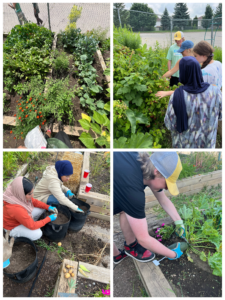 The St. Benedict team was hard at work this summer to maintain and nurture the garden. As they worked in the hot days of the summer, a garden leader (Eli) came up with the idea to create a space for them to cool off, relax, and reflect on the hard work they had done. The vision included a shaded area (a.k.a. Project Shade) along with a garden map and a whiteboard to track produce grown and jot down any important notes.
The St. Benedict team was hard at work this summer to maintain and nurture the garden. As they worked in the hot days of the summer, a garden leader (Eli) came up with the idea to create a space for them to cool off, relax, and reflect on the hard work they had done. The vision included a shaded area (a.k.a. Project Shade) along with a garden map and a whiteboard to track produce grown and jot down any important notes.
As the team discussed how they would implement “Project Shade”, they began to research materials to use and soon realized there was unused material around the garden. As they walked around finding new and different materials, they brainstormed which would be the most beneficial. Testing out trellises and bamboo curtains, they came across some unused plastic roofing panels that would be perfect for the project.
It was important to the team to reuse material in the garden so that the improvement funds could be used for other materials, such as the garden bed map. The garden map was designed by one of the garden leaders (Cecylia), helping to organize nearly 11 garden beds. It also allows communication among other team members through shared notes and updates.
They have done a great job utilizing and reusing materials around the garden, as well as watering and nurturing it. As they plant new seeds for the school year, they hope their peers will enjoy the fruit of their labour.
And a thank-you to our funders & partners:

Region of Waterloo Community Environmental Fund
Kindred Credit Union
Spark Potential Canada
Farm Credit Canada
Bloomberg Youth Climate Action Fund
Grand River Agricultural Society
TD Friends of the Environment Foundation
The Catherine and Maxwell Meighen Foundation
R. Howard Webster Foundation
The Peterborough K.M. Hunter Charitable Foundation
Grower’s Choice
